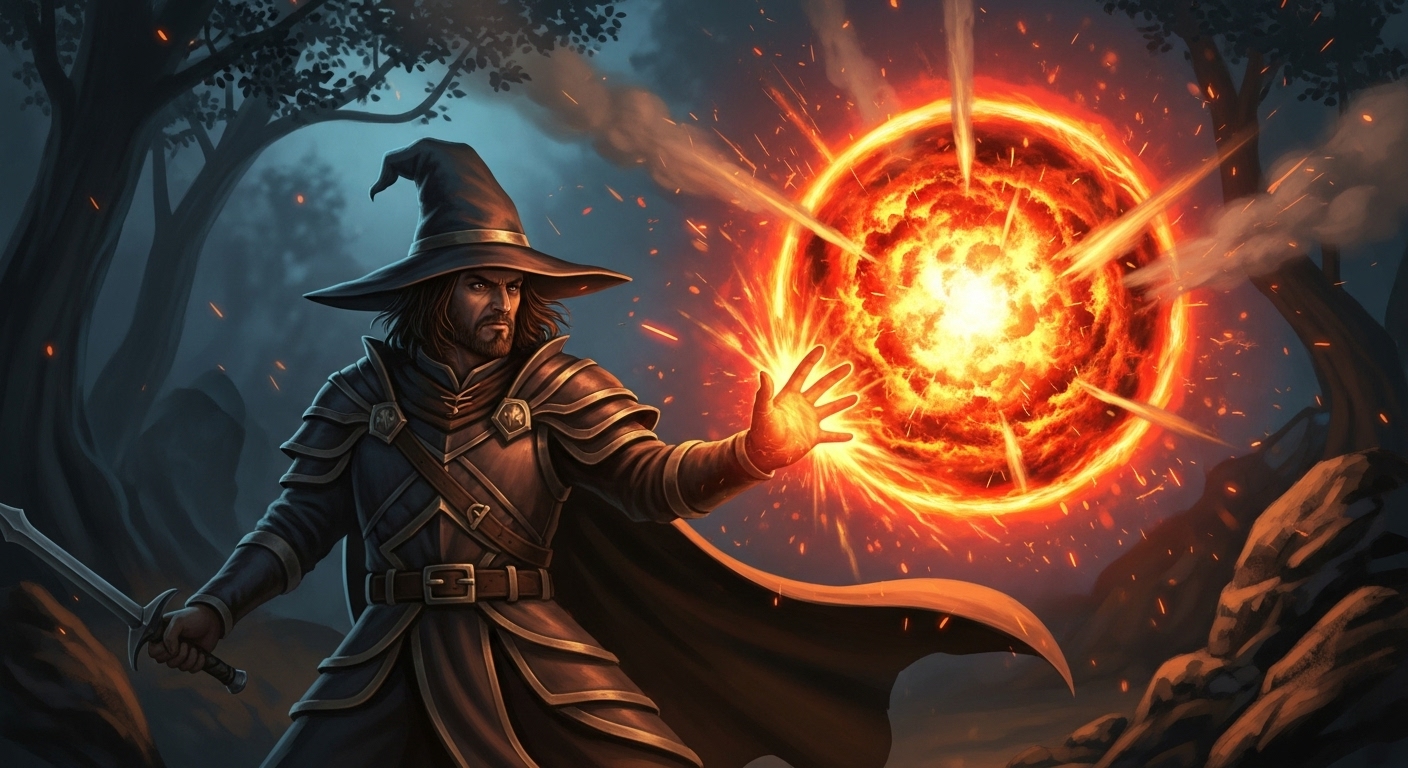Fireball

- Level: 3
- School: Evocation
- Class: Sorcerer, Wizard
- Casting Time: Action
- Range: 150 feet
- Components: V, S, M (a ball of bat guano and sulfur)
- Duration: Instantaneous
A bright streak flashes from you to a point you choose within range and then blossoms with a low roar into a fiery explosion. Each creature in a 20-foot-radius Sphere centered on that point makes a Dexterity saving throw, taking 8d6 Fire damage on a failed save or half as much damage on a successful one.
Flammable objects in the area that aren't being worn or carried start burning.
Using a Higher-Level Spell Slot. The damage increases by 1d6 for each spell slot level above 3.
Tactical Usage
Area Devastation: Fireball provides classic area damage and explosive battlefield control. This 3rd-level evocation spell excels at eliminating groups of enemies and controlling encounter areas.
Optimal Timing: Deploy against clustered enemies, when area damage is crucial, or for clearing multiple weaker threats simultaneously.
Resource Management: Uses a 3rd-level spell slot - available from character level 5+. Instantaneous effect with significant area coverage.
Target Selection: 20-foot radius sphere centered on point within 150 feet. Affects all creatures in area.
Spell Combinations
Synergistic Spells:
- Area Control: Combine with web or entangle to group enemies before detonation
- Damage Enhancement: Layer with vulnerability effects to maximize fire damage
- Positioning Magic: Pair with misty step for optimal casting position
Class Feature Interactions:
- Sculpt Spells: Evocation wizards can protect allies from fireball damage
- Elemental Affinity: Sorcerers with fire bloodline enhance damage and spell attack effectiveness
- Spell Critical: Features that enhance spell damage improve explosive effectiveness
Multi-Caster Coordination: Multiple fireballs can devastate large areas or guarantee elimination of priority targets.
Material Component Details
Component Acquisition: Tiny ball of bat guano and sulfur - obtainable from alchemical suppliers or natural sources.
Component Handling: Classic explosive components representing fire magic and combustion.
Roleplay Opportunities: Different explosive materials might reflect regional alchemy or personal fire magic style.
Economic Considerations: Minimal component costs for devastating area damage capability.
Creator Notes
Encounter Balancing: 8d6 fire damage to large areas dramatically affects encounter balance and enemy positioning.
NPC Usage: Enemy wizards and sorcerers frequently use fireball as signature area damage spell.
Environmental Considerations: 20-foot radius affects significant encounter area. Can ignite flammable objects.
Campaign Integration: Iconic damage spell that defines area evocation magic and tactical positioning.
Environmental Interactions
Terrain Effects: 20-foot radius explosion affects large encounter areas. Can damage structures and ignite materials.
Weather Influence: Unaffected by weather conditions, providing reliable damage regardless of environment.
Structural Interactions: Can damage buildings, set fires, and affect environmental objects within blast radius.
Elemental Interactions: Fire damage interacts with creature resistances and environmental flammability.
Common Rulings & Clarifications
Timing Questions: Action casting time with instantaneous effect. Explosion occurs immediately at target point.
Target Limitations: 20-foot radius centered on point within 150 feet. All creatures in area make Dexterity saves.
Duration Interactions: Instantaneous damage with potential ongoing fire effects on flammable materials.
Mechanical Interactions: 8d6 base fire damage, +1d6 per slot level above 3rd. Dexterity save for half damage.
Alternative Applications
Non-Combat Uses: Demolition work, obstacle clearing, creating dramatic effects, or environmental modification.
Social Encounters: Intimidation displays, demonstrating magical power, or creating dramatic negotiation punctuation.
Exploration Applications: Clearing blocked passages, destroying obstacles, or accessing areas through controlled demolition.
Utility Functions: Demolition assistance, obstacle removal, intimidation tool, or environmental modification.
Related Spells
Same School: Other evocation spells like magic missile (1st level guaranteed damage), lightning bolt (3rd level line damage), meteor swarm (9th level ultimate area damage).
Similar Effects: lightning bolt (3rd level line damage), cone of cold (5th level cone damage), meteor swarm (9th level ultimate area).
Progression Options: burning hands (1st level cone), fireball (3rd level sphere), delayed blast fireball (7th level enhanced), meteor swarm (9th level ultimate).
Complementary Magic: web (group enemies), misty step (positioning), counterspell (prevent enemy responses).
Scaling Analysis
Level Progression: Remains competitive throughout campaigns as signature area damage, scaling with upcasting.
Upcast Benefits: Additional 1d6 damage per slot level above 3rd makes higher-level casting devastatingly effective.
Campaign Phases: Peak effectiveness in mid-level play (5-10) where area damage provides maximum tactical value.
Comparative Value: Exceptional area damage that justifies 3rd-level slot and defines evocation spellcasting.
Narrative Flavor
Casting Description: A bright streak flashes from your finger to the target point where it erupts in brilliant orange and red flames.
Effect Manifestation: A massive explosion of fire and force engulfs the area in a spectacular display of destructive magical energy.
Personal Style: Wizards create precisely calculated explosive formulae, while sorcerers manifest instinctive fiery destruction through raw magical power.
World Integration: Represents iconic evocation magic available to arcane casters, often associated with war magic, destructive spellcasting, or classic wizardry traditions.